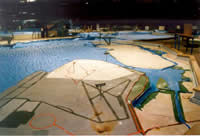
|
Model Scales (Model to the Bay)
| Horizontal: |
1 foot = |
1000 feet |
| Vertical: |
1 foot = |
100 feet |
| Velocity: |
1 foot/ second = |
10 feet/second |
Time
|
1 Minute = 1 Hour 40 Minutes
|
|
14.9 Minutes = 1 Lunar Day
|
|
7.2 Hours = 30 Lunar Days
|
Bay Model Color Code
|
Beige |
|
|
Major Urban Areas
_
|
|
|
Black |
|
|
Breakwaters & Dikes
_ |
|
|
Blue |
|
|
Water
_ |
|
|
Dark Brown |
|
|
Uplands
_ |
|
|
Dark Grey |
|
|
Industry, Airports
& Landfills |
|
|
Green |
|
|
Marshes, Mudflats, Diked Islands & Parklands |
|
|
Red |
|
|
Roads & Bridges
_ |
|
|
|
Copper Tags
The 250,000 copper tags rising out of the model floor compensates for the impact of its distorted scale. Because the Bay is so shallow, if the same scale were used both the horizontal and vertical aspects, the water in the Model would not be deep enough to measure. The vertical scale is ten times greater than the horizontal scale, further exaggerating the Model’s depth. Due to this difference, the water in the Model flows faster than the actual Bay. The copper tabs create water flow resistance so the model can be calibrates to reflect actual conditions in the Bay.
Tide Generation and Control
Tidal simulation is achieved by the use of a computer controlled pump and valves to raise or lower the water level in the model. The pump moves water between a sump pool and the Pacific Ocean portion of the model. The computer controlled valves determine water level in the model.